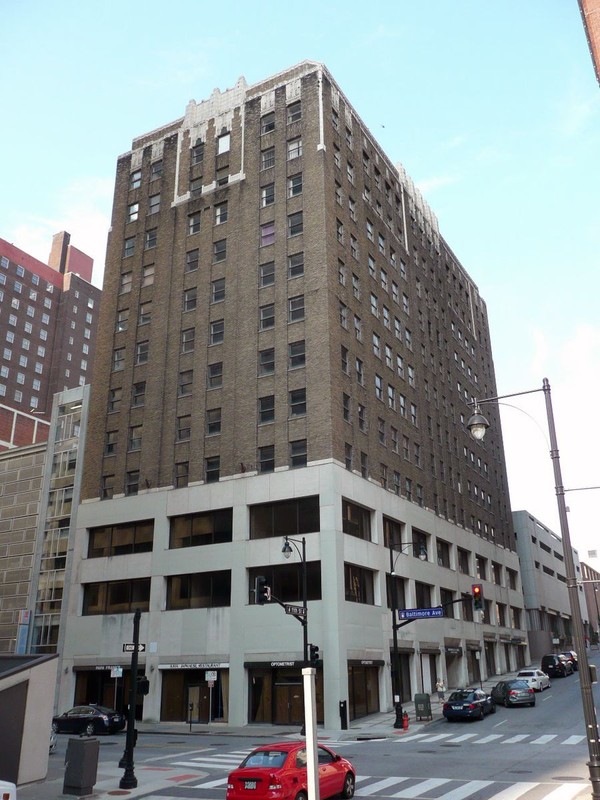The Fairfax/Brookfield Building (Hotel Indigo)
Introduction
Text-to-speech Audio
Completed in 1930 and developed by Eleventh & Baltimore Corporation, Kansas City's Fairfax Building brought 86,000 square feet of rental space just as the nation was entering the Great Depression. Initially named the International Building, it was later renamed after the nearby Fairfax Airport's owners, Woods Brothers Corporation. Designed by architect Alonzo Gentry in Art Deco style, the twelve-story building at 101 W. 11th Street was home to railroad companies and automobile manufacturers, two leading industries at the time. It was later home to the offices of airline companies like TWA and Delta Airlines. The location at the center of the business district, modern amenities, and proximity to transportation hubs attracted businesses seeking a regional headquarters. With its adaptable office spaces and convenience to amenities, the Fairfax Building continued to evolve, reflecting the changing demands of transportation and commerce in the region. The building is now home to Hotel Indigo and offers 118 rooms.
Images
The Fairfax Building

Backstory and Context
Text-to-speech Audio
The 1920s saw tremendous growth in Kansas City, continuing a trend that began shortly after the Civil War and accelerated in the late 19th century. At the beginning of the 20th century, the population boomed as the railroad brought commerce to the area, which attracted investment and new businesses. According to the 1900 census, the city had 163,000 residents, ranking it 22nd in the nation. In thirty years, this would more than double to 400 thousand residents. Over 190 buildings were being constructed in the city during the summer of 1929, with an aggregate value of 30 million dollars. Accounting for inflation, this represented around half a billion dollars in today's money. Two months after this building was completed, the most significant stock market crash in history served as a harbinger to continued declines that shook the country. The Great Depression that followed made many of these real estate investments untenable. However, the Fairfax Building at 101 W 11th Street was an exception. Just weeks before the stock market crash, a demolition permit was granted to the property to level the vacant Gotham building, which once housed the University Club of Kansas City.
Opened in 1930 as the International Building, the structure was later renamed the Fairfax Building in honor of the Woods Brothers Corporation, which owned the nearby Fairfax Airport. The Wood Brothers were among the first to lease office space in the building, providing a space where residents and visitors alike could come and arrange travel out of the Fairfax Airport. There was also a transportation service connecting the building with Union Station.
The Fairfax Building's appeal was its proximity to other downtown businesses, along with its unique open floor design, which allowed for flexible office space for various tenants. While vacancies were common in the early years of the Depression, companies like insurance firms began occupying space in the building in 1935. Over the years, the Fairfax Building housed various tenants, including automobile companies like Chrysler, DeSoto, and Dodge Brothers, as well as the Ford Motor Company. The building was best known for its long-standing association with numerous railroad companies that occupied office space from the 1930s until the 1960s. These rail companies, such as the St. Louis and San Francisco Railroad, the Santa Fe Railroad, and the Seaboard Airline Railway, played a vital role in Kansas City's transportation industry, handling passenger and freight services. In the 1950s, the Fairfax Building housed airline businesses like Trans World Airlines (TWA) and Trans Canada Airlines. By 1960, KLM Royal Dutch joined the building, while Delta Airlines remained by 1965. The Woods Brothers had a strong presence in the building, along with MoKan Pipeline and Panhandle Eastern Pipeline Company.
The building changed hands several times in mid-century. On August 3rd, 1975, the Unitog Company acquired the building and renamed it the Brookfield Building. The company would employ thousands of workers nationwide but would not stay in the Brookfield Building for long. The property was mostly vacant by the 2000s and completely empty when it was sold in 2010 to a developer who converted the property to a hotel. This project not only gave the space new life but also restored the building to its historic character by removing prior additions to the façade.
Sources
Millstein, Cydney. National Register of Historic Places Nomination Form - The Fairfax Building, MoStateParks. February 6th, 2015. Accessed July 15th, 2024. https://mostateparks.com/sites/mostateparks/files/Fairfax%20Bldg.pdf.
Nichols, Joel. Hotel Indigo revitalizes historic building in downtown KC, January 18th, 2018. Accessed July 15th, 2024. https://www.kshb.com/news/local-news/hotel-indigo-revitalizes-historic-corner-of-downtown-kc#:~:text=For%20a%20big%20chunk%20of,to%20buy%20tickets%20for%20travel..
Collison, Kevin. Historic Brookfield Building Reopening Soon as Hotel Indigo and Fairfax Lofts, November 17th, 2017. Accessed July 15th, 2024. https://flatlandkc.org/eats-drinks/historic-brookfield-building-reopening-soon-as-hotel-indigo-and-fairfax-lofts/.
https://commons.wikimedia.org/wiki/File:The_Fairfax_Building,_Kansas_City,_Missouri.jpg
